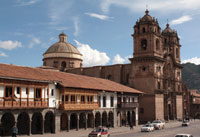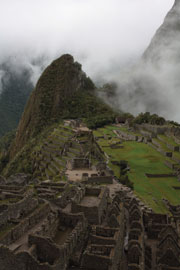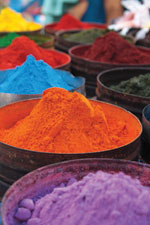You’ve seen the photos: On the crest of a mountain deep in the Peruvian jungle, Machu Picchu sits regally, blanketed in deep green terraces and bathing in the summer sun.
The image is something of an iconic representation of Peru, and for good reason. Machu Picchu, the “Lost City of the Inca,” is the most visited tourist attraction in the country and is among the most historically interesting and visually stunning sites in South America. Its mountaintop terraces are recognized by people far and wide.
But there’s a deeper reason why Machu Picchu is so representative of Peru: The abandoned city is one of the legacies of the Inca, the indigenous people whose heritage is an integral part of Peruvian history and culture. In many ways, the story of Peru is the story of the Inca and the other native groups that have lived in the Andes since before the time of Christ.
I spent 10 days in Peru this spring as a guest of Go Ahead Tours, exploring cities and countryside from the Andes to the desert to the shore of the Pacific Ocean. Along the way, I discovered the natural beauty of the country, as well as its rich archaeological sites and the fascinating and complex people who created them.
Lines in the sand
Some of the earliest evidence of human inhabitants in Peru can be found near Ica, a small city south of Lima between the mountains and the sea. People have lived in the area since prehistory, and one of the most advanced groups, the Nazca, left elaborate line drawings in the earth to mark their place in time.
On our four-hour bus ride from Lima to the Nazca Lines, our excursion guide, Miguel, told us some background about human history in the area.
“People were living here in Peru 6,000 years before Christ,” Miguel said. “What was happening here wasn’t happening in your country until 1,600 years after Christ.”
The Nazca civilization thrived in the area from about 600 B.C. until A.D. 700, when they were conquered by a neighboring people. Around 500 B.C., they created the lines, a series of long trenches dug into the desert sand, between 60 and 200 meters long. From the ground, the shapes of the lines are indiscernible; from the air, though, visitors can see the unmistakable forms of animals, humans and geometric shapes.
Some of our group took the optional flight from Ica to see the lines from a 12-seat, single-engine Cessna. About 20 minutes after takeoff, our pilots began to point out the incredible shapes, first geometrical figures like trapezoids, then full-on sand drawings of a monkey, a dog, an albatross, even an “astronaut.” The pilots would pitch the plane to one side and circle each figure several times so that we could see it clearly and take pictures.
Back on the ground, we asked Miguel for more details about the drawings and their purpose.
“The Nazca used these figures like signs of the zodiac, to keep track of their seasons,” he said. “But we still don’t know how they created the drawings so perfectly on the ground.”
Cuzco: The Inca capital
From the beginning of the 13th century until the Spanish arrived in the early 1500s, the Inca people dominated Peru, and they left a cultural legacy that still endures throughout the country. During the peak of their empire, the mountain city of Cuzco was their headquarters; today, the city is a central point of tourism in the country, welcoming around 1 million visitors each year.
During our tour, we spent six nights in Cuzco, taking several days to explore the city and surrounding areas. At an altitude of more than 12,000 feet, Cuzco enjoys a beautiful, temperate climate. The city’s urban highlights, such as the centrally located Plaza de Armas, are pristine examples of Spanish colonial architecture and make the city a great place to spend a day’s worth of free time.
We spent one day in exploring Cuzco’s Inca sites with local guide Otilia, who is herself a descendant of the Inca people. We began at Qorikancha, an Inca temple in the center of town.
“Qorikancha was the richest Inca temple in this area,” Otilia told us as we walked through the ruins. “Most of them were destroyed by the Spanish in 1532.”
The temple was constructed out of large blocks of granite, cut into precise shapes, fitted together without mortar and polished to a sheen. These massive walls have survived more than 500 years of earthquakes that have devastated even modern Peruvian buildings. At intervals along each wall, a niche was created to hold gold and silver temple items, which have long since disappeared.
We also visited Saqsayhuamán, a massive fortress built in the mountains above Cuzco from 1350 to 1488. Like the temple, this fortress was constructed of large cut stone, stacked without mortar to create perfectly straight walls.
“More than 10,000 workers built this fortress,” Otilia told us. “Look at how beautiful and smooth the Incas carved the rocks. They’re like Legos for children.”
The mist of Machu Picchu
The tourist brochures and magazine covers may show a mountaintop city awash in sunshine, but on any given day, you’re more likely to find Machu Picchu shrouded in mist as it was on the day of our visit. Though it may not yield the impressive photos that a sunny day would, a rainy visit gives a better perspective of how the Inca who lived there would have known the city, with a constant drizzle overhead and wisps of mist billowing out from the valley below.
There are only two ways to reach Machu Picchu: hike along the Inca Trail, which cuts hundreds of miles through the Andes, or take the train from Cuzco to Aguascalientes, the gateway city to the national park. There are no roads to Aguascalientes, so most tourists opt to come the way we did, traveling about three hours each way by train.
 Either way, what greets you at Machu Picchu is nothing short of spectacular. No matter how many images you’ve seen or how many times you’ve visited Indian ruins throughout South America, nothing can prepare you for your first glimpse of the hidden city, with its towering stone buildings and green terraces carved into the face of the mountain.
Either way, what greets you at Machu Picchu is nothing short of spectacular. No matter how many images you’ve seen or how many times you’ve visited Indian ruins throughout South America, nothing can prepare you for your first glimpse of the hidden city, with its towering stone buildings and green terraces carved into the face of the mountain.
Machu Picchu was constructed starting in 1450 as a retreat for the Inca king, who would visit several times each year. Jose Luis, a slight local man of Inca descent, guided us on a two-and-a-half-hour tour through the site, helping us to understand what we were seeing.
“It took 3,000 builders 40 years to build this city,” he told us. “We’re going to see houses, an astronomical observatory and many temples. It was a religious city.”
As we explored the site, we walked up and down the mountain terraces that make Machu Picchu so memorable. Jose Luis explained that these terraces were created for farming, allowing the Inca to plant crops along the side of the mountain. Today, a number of alpaca roam free on the site’s terraces, feeding on their grasses and interacting with visitors.
About 500 people inhabited the city until 1537, when the Spanish arrived in Cuzco and overtook the Inca capital. The Inca quickly abandoned Machu Picchu, which the Spanish never found. It wasn’t until 1911 that an English explorer rediscovered Machu Picchu, almost perfectly preserved by the high jungle plant life that had overtaken it.
Today’s visitors get a fascinating look at what life in the historic city must have been like.
“The king’s palace is the only building in the city with a private bathroom,” said Jose Luis as we explored the palace ruins. “There are also 11 caves in the city that were public bathrooms for everyone else.”
Jose Luis took us through temples, military outposts and private homes, explaining details about Inca religious beliefs and social structures. He also told us that the site’s days as a tourist destination may be numbered.
“Machu Picchu is sinking,” he said. “Geologists say that it’s slowly sinking from the rain and from all of the tourism. They say that to save it, we’re going to have to close it to visitors some day.”
Sacred Valley of the Inca
Though Inca control of Peru ended with the arrival of the Spanish, the Inca people never went away. In parts of the country, such as the rural areas outside of Peru, entire towns are full of Inca descendants who still speak their historical language and wear the customary indigenous clothes.
After returning from Machu Picchu, we spent a day exploring the Sacred Valley of the Inca, a region near Cuzco where the indigenous people practice many traditional customs in smaller communities. This region is still largely agricultural, producing more than 700 varieties of potatoes.
“It’s a very simple, easy life for the people here,” Otilia said, rejoining us for this day tour. “They are not rich, but they are happy people.”
Daily life comes into focus in the town of Pisac, where locals hold a market in the main square every Sunday. We spent a few hours of free time exploring the market, which sells souvenirs for tourists and staples for local residents. 
On the day of our visit, the market was packed, and a whirlwind of sights and sounds. The plaza was full of modern Inca residents, short and dark-skinned with distinctive facial features. Many wore the traditional colorful hats, skirts and tunics that are so widely associated with Andean culture.
Roaming the market stalls, I found an endless array of items for sale: fresh fruit, textiles and colored corn, not to mention dozens of varieties of potatoes. One woman set out a dozen canisters of brightly colored powders, telling us that they were natural dyes used for generations by the Inca to create their vibrantly colored clothing.
Looking back on it now, I can see these humble natural dyes as a symbol of the native people throughout the country — though time marches on around them, the Inca and their predecessors are reminders of a rich past, and their colorful culture will always make Peru unique.









